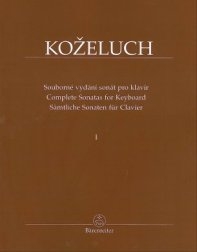 By
the end of the eighteenth century Koželuch was the composer "most
celebrated in all of musical Europe" for reasons summed up by Charles
Burney: "His style is more easy than that of Emanuel Bach, Haydn or
Mozart; it is natural, graceful, flowing", "pleasing" and "pure". For
more than a quarter of a century he defined the musical tastes of the
aristocracy and general public alike, in the music capital of the world,
Vienna.
By
the end of the eighteenth century Koželuch was the composer "most
celebrated in all of musical Europe" for reasons summed up by Charles
Burney: "His style is more easy than that of Emanuel Bach, Haydn or
Mozart; it is natural, graceful, flowing", "pleasing" and "pure". For
more than a quarter of a century he defined the musical tastes of the
aristocracy and general public alike, in the music capital of the world,
Vienna.
However, his very accessibility has been the cause of his subsequent
neglect; after his death fashion had moved on and "pleasing" became a
dismissal, and more recent musical scholarship has preferred to focus on
the great masters of the period.
In his Introduction, Christopher discusses Koželuch's place in musical
history, not only as a composer whose sonatas display to perfection
precisely the features required of a sonata by theorists of the period,
but also as innovator in his own right; both his anticipation of
Beethoven's and Schubert's tragic-pathetic manner, and his creation of
the fêted cantabile idiom, have been seen as chance if not
overlooked entirely, along with his frequent, less easily-defined
harmonic adventurism. His preference for the fortepiano over the
harpsichord and clavichord also marks a significant break with the past;
his writing is highly idiomatic to the newer instrument.
 The
four-volume series presents the sonatas chronologically, the first
volume covering the period 1780-1784; Volume II (1784-86) is expected
later this year. The internationally-accepted spelling "Koželuch" has
been retained, the variant "Koželuh" being only a more recent
development, though one favoured by many modern-day Czechs. As well as
Christopher's Introduction, this Urtext edition provides facsimiles and
full critical notes, as well as a thematic index to the series.
The
four-volume series presents the sonatas chronologically, the first
volume covering the period 1780-1784; Volume II (1784-86) is expected
later this year. The internationally-accepted spelling "Koželuch" has
been retained, the variant "Koželuh" being only a more recent
development, though one favoured by many modern-day Czechs. As well as
Christopher's Introduction, this Urtext edition provides facsimiles and
full critical notes, as well as a thematic index to the series.